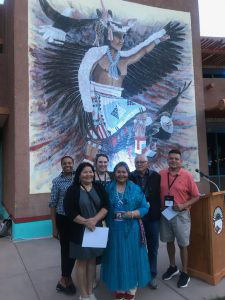General
10th Annual Tribal Public Health Summit convenes
Today’s guest blogger, Yasmin Bowers, senior environmental health fellow with APHA’s Center for Public Health Policy, writes about her experience attending the recent Tribal Public Health Summit in Albuquerque, New Mexico, and how it relates to her work with the Tribal Public and Environmental Health Think Tank.
 Last month, over 600 tribal public health professionals, researchers and community-based service providers attended the National Indian Health Board’s 10th Annual Tribal Public Health Summit. Held May 13-15 in Albuquerque, New Mexico, the gathering featured speakers, workshops, roundtables and more offering a comprehensive overview of current tribal public and environmental health challenges and solutions.
Last month, over 600 tribal public health professionals, researchers and community-based service providers attended the National Indian Health Board’s 10th Annual Tribal Public Health Summit. Held May 13-15 in Albuquerque, New Mexico, the gathering featured speakers, workshops, roundtables and more offering a comprehensive overview of current tribal public and environmental health challenges and solutions.
As the new senior environmental health fellow with APHA’s Center for Public Health Policy, I was pleased to attend as a part of my work with the Tribal Public and Environmental Health Think Tank. The Think Tank is a work group convened since 2011 by APHA, with support from the Centers for Disease Control and Prevention. It aims to raise awareness about and make equitable improvements to the unique public and environmental health challenges faced by tribal and indigenous communities across the country.
Summit themes aligned well with the Think Tank’s six priorities in tribal public health: food sovereignty and access, infrastructure and systems development, climate and health, resource extraction, clean air and clean water. The Think Tank established these priorities as part of a report to build understanding of tribal public and environmental health issues and increase support for initiatives that address these concerns.
At the Summit’s “Environmental Health Roundtable,” community leaders provided specific examples of the kind of concerns outlined in the Priorities in Tribal Public Health report. These included air quality and mine dust, water quality and resource extraction, food gardening and food sovereignty projects, traditional ecological knowledge workshops and climate change and paralytic shellfish poisoning.
 The examples resonated with the audience and with one of APHA’s founding Think Tank members, who I spoke with at the Summit. Rosemary Ahtuangaruak shared with me her own experience as a community public health advocate and political leader from the Village of Nuiqsut, Alaska. She is researching the impacts that local energy companies have on her Inupiat community of the Arctic Slope, obtaining and analyzing air release data that could have local health implications.
The examples resonated with the audience and with one of APHA’s founding Think Tank members, who I spoke with at the Summit. Rosemary Ahtuangaruak shared with me her own experience as a community public health advocate and political leader from the Village of Nuiqsut, Alaska. She is researching the impacts that local energy companies have on her Inupiat community of the Arctic Slope, obtaining and analyzing air release data that could have local health implications.
Ahtuangaruak emphasized the disconnect between health, wellness and national energy policies that impact her community and others. And because so many environmental impacts on the health of tribal populations, including air pollution, are exacerbated by climate change, we both found the Summit’s “Collaborative Climate Adaptation for Tribal Community Well-being” session engaging.
It looked at how the Pala Band of Mission Indians of San Diego County, California, is implementing a climate adaptation plan that engages community stakeholders in increasing tribal health, well-being and resilience. The project builds on previous work the Pala tribe has done to assess its own climate health vulnerability and to help prepare tribes across the country through the EPA-funded Tribal Climate Health Project.
Chances like this to learn more about current public and environmental health issues that disproportionately impact tribal communities, and to better understand the importance of incorporating culture, community and spirituality into tribal public health initiatives are invaluable. And I look forward to hearing more from Rosemary Ahtuangaruak when the Think Tank convenes in July.
Photos from top: Yasmin Bowers is senior environmental health fellow for APHA’s Center for Public Health Policy. Summit attendees Yasmin Bowers, Morita Yazzie, Mariah Norwood, Former Miss Navajo Nation Ms. Sonny Dooley, Tincer Yazzie, Sr. and Tincer Yazzie, Jr.


